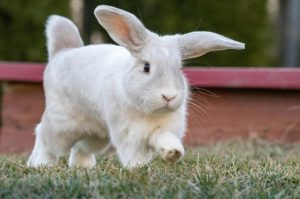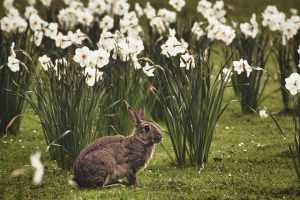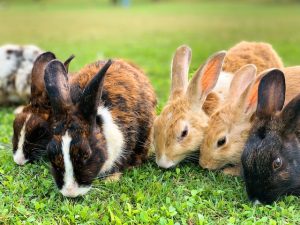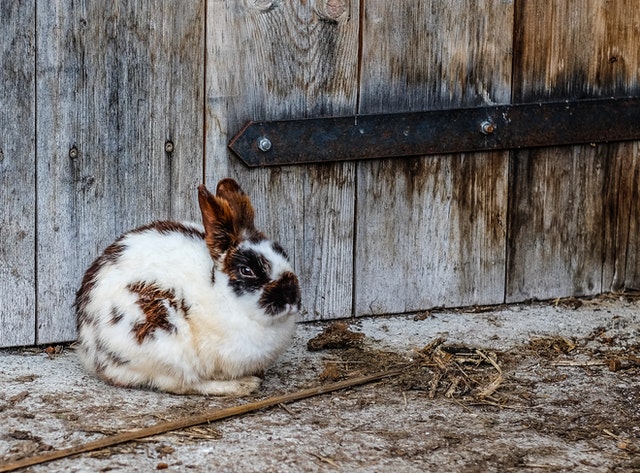
Although highly debated, the origin of the Checkered Rabbit is believed to be from Europe, in France. It is thought to be that they originated from the Giant Flemish and the French Lops. They were brought to and recognized through the American Rabbit Breeders Association in 1910.
The Checkered Rabbit is a show Rabbit. It is not bred for a commercial process, such as meat. The Checkered is one of the large or Giant breed rabbits. What sets the Checkered Rabbit apart from the rest of the breeds is everything about this gentle giant.
Contents
Size and Appearance
The Checkered Rabbit is one of the Giant breeds. The gentle giant grows to be one of the largest across the breeds. The males, who are fully matured will grow to be 11 pounds, the mature females can reach a weight of 12 pounds.
They are known to be a slender body type, yet quite muscular. The body is long and resembles that of a hare. The back does have a slight arch to it. The Checkered Rabbit’s legs are long and very powerful. Their head is round and he or she has wide ears that stand erect.
Coat
The Checkered Rabbit’s coat is called a rollback coat. This means that when the fur is brushed in the opposite direction, it will fall back into place. However, even with the thick and soft fur, they do not require extensive assistance when it comes to grooming. The coat is soft, but thick.
It is recognized by the American Rabbit Breeders Association for having the distinct markings that set it apart from other breeds. The only Checkereds that are accepted as Checkered Rabbit are the ones that are white with either black or blue markings. The markings will be found around the eyes of this rabbit, on the ears, the back will have a stripe along the spine. There will also be a small butterfly pattern on the nose. The cute little cheeks will also have a touch of color on them.
Temperament
The Checkered Rabbit is not known for being affectionate, as many of the other breeds are. These bunnies are gentle, and they are friendly. This does not mean that they are grumpy bunnies, they will be affectionate often, just not as often as we may like. One way to look at it, is that the Checkered Rabbit is not as needy as many of the other breeds. It is possible that your Checkered Rabbit is unlike most. Once he or she knows you, they may want to spend time together. They are not quite as cuddly, but may make the effort to gain your love back.
As with all rabbits, you need to respect personal space. If the Checkered Rabbit is startled or becomes frightened, he or she may attempt to bite you. It is always wise to say the bunny’s name as you walk towards it to prevent startling it or scaring him.
These little giants are very energetic. They need a human that can keep up with this energy. They need lots of interactive toys to play with, room to run and play on their own also. When the Checkered Rabbit becomes bored, he could become destructive to furniture, wiring, shoes almost anything.
Life Expectancy

The Checkered Rabbit can live a long and happy life when well cared for. The average lifespan is between 5 and 8 years. Although, they have been known to live longer, maybe up to ten years.
Food and Daily Needs
Obviously, you will want to be feeding your Checkered Rabbit a healthy diet filled with nutrition. To begin, you must know that 70% of the food they have each day should be good quality hay, such as Timothy. The amounts of each type of food should be based on the size, age and activity level of your rabbit.
Your veterinarian can help determine how much and what to feed. They are a large, giant breed of rabbit, they will need more than the average bunny. Feeding additional food such as rabbit pellets and fresh vegetables, along with fresh water throughout the day are the basic needs of all rabbits for dietary purposes.
As a reminder, the hay is necessary for not only the digestive tract, but also to help their teeth. They gnaw on the hay which helps to prevent their teeth from overgrowing. The supplemental pellets contain extra vitamins and minerals so the rabbit has what they need daily. As with all animals, do not overfeed your Checkered Rabbit. They tend to become overweight easily. Especially if they are not exercising much.
On average, it is believed that a rabbit, if in the wild, will run up to three miles a day. The rabbit will need at least three hours of free time to run and play. This could be throughout the house or outside in a closed off area. I usually suggest an area that is fenced in and has a roof made of wire. This gives them plenty of room to roam around and yet they are protected from larger predators. If you can provide a sort of kennel and dog run, your rabbit will be a very happy and worn out giant bunny.
This also means that they are safe and secure and you will be able to do other chores while the rabbit is in the play area. If this area could be attached to the outdoor hutch it would make it ideal. The hutch needs to have an area that is protected from the inclement weather that happens. It also needs to be large enough so that the bunny does have room to move around. Separate areas, with enough distance between them for where the food is at, where they go potty and also where they sleep.
Family and Training
The Checkered Rabbit will fit into a family that has older kids, a single person household or for seniors as a companion. They form bonds with their humans easily. Due to the size they can become, families with younger children need to supervise the younger kids when they are with the rabbit.
The checkered would be comfortable with indoor or outdoor living. Again, as long as they have protection from predators and weather, they will do nicely wherever they are. Most veterinarians will recommend that you keep the Checkered in an outdoor hutch. The hutch will need to be large enough to give your rabbit plenty of room. However, being a giant rabbit, all areas need to have the space they need.
They would be just as happy living indoors also. If it is possible, a hutch that is built with multiple stories will help this energetic rabbit stay active. As is often said when it comes to giants of any type, ‘The bigger the better!’ This is most certainly true when it comes to where they live. If they have loads of room to run and play, they are happy little critters. Being cooped up in a small space can cause depression and some hard feelings on behalf of your Checkered Rabbit.
Health Issues
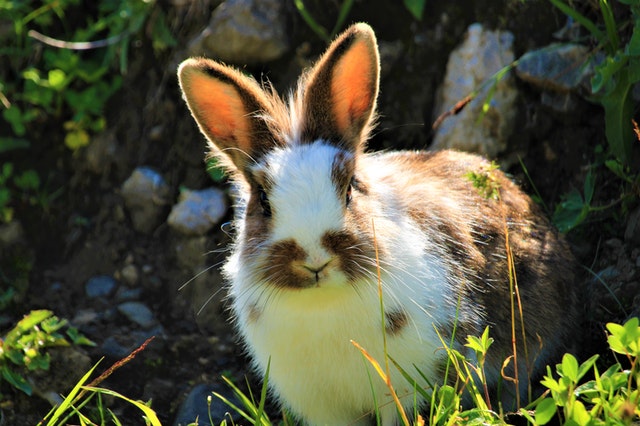
Thankfully, the Checkered Rabbit does not have any serious diseases that they are predisposed to. The health problems your bunny could experience are common and well known issues for rabbits. Most of the issues are situations that can be easily remedied with the Veterinarian. You should be seeing a veterinarian on a routine basis. So, in actuality, many of these can be spotted immediately and treated right away. Some of the common concerns to watch for include, but are not limited to:
Ear mites are a common parasite. You will see your bunny shaking his head quite a bit. Get him checked for these. GI Stasis can be deadly if not caught and treated quickly. This is when the digestive tract slows way down or stops functioning altogether. This would be seen by lack of appetite, lethargy and little to no fecal pellets
Malocclusion is when the teeth do not align properly. This makes it difficult for the rabbit to eat properly, which also allows the teeth to grow more. This is helped and can be prevented by regular dental check ups. One other concern could be back issues. This will happen if the rabbit is picked up improperly or dropped, even if by accident. Young children should always be supervised when playing with any animals.
Grooming
You should very seldom need to give your Checkered rabbit a bath. They usually keep themselves very clean. Besides, bathing can be a stressful activity for them. Brushing will only need to occur once a week. During the shedding seasons, this should be increased to three times a week. Your rabbit’s nails will need to be trimmed as needed. You can build an amazing bond once your Checkered Rabbit gets to know you. They say this breed is not as affectionate, however, once you get to know each other, the affection will be shown.



